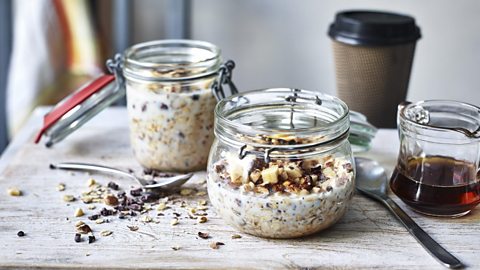Which plant-based ‘milk’ is best?
Supermarkets and health food shops are awash with milk alternatives, from oat and soya to rice and coconut. But which ones are best for your health, for cooking with and for the environment? Sue Quinn investigates.

Whether you have a dairy intolerance, want to cut back on animal products or just prefer the taste, there are lots of reasons why alternative ‘milks’ might appeal. We’re certainly lapping them up in the UK – sales were expected to total £458 million in 2023, according to consumer group Mintel.
This rise in demand has also seen a huge boom in the range available – shops are in no short supply of different types and styles, made from various ingredients and designed for everything from making fancy coffees to pouring over your cereal.
But how do these popular plant-based drinks compare when it comes to flavour, nutrition and their impact on the environment?
That can be a tricky question to answer, says Day Radley, chef and founder of The Vegan Chef School. “It’s worth remembering there can be a big difference between brands, even when their milks use the same base ingredient,” she says.
Here’s what to consider when you find yourself staring blankly down an aisle of plant-based milk alternatives, with no idea which to choose.
Uses
In terms of cooking, any type of plant-based milk can simply be swapped for dairy in most recipes. They are particularly good in bakes and pancakes, says Radley. “But you do have to consider whether the milk is sweetened or not.” She recommends unsweetened, so you can control the sweetness and use it in both sweet and savoury cooking.
“Pay attention to the other flavours going on in what you’re cooking,” Radley suggests. “For example, coconut or almond milk work well in banana bread, but I wouldn’t use either in apple cake, because I don’t like that flavour combination.”
Vegan cinnamon buns
These buns can be made with soya or almond milk

Nut milks tend to thicken dishes like sauces, porridge and polenta more quickly than dairy. “So, take care to watch the pot carefully, keep the heat low and cook gently so it doesn’t over-thicken,” Radley says. “You might need to add more plant-based milk than the recommended amount for dairy.”
Most are fine to splash in hot drinks and generally don’t ‘split’ or curdle because stabilisers are often added these days. “But it does depend on the brand,” Radley says. Again, consider the flavour of what you’re adding the milk to. Coconut milk tastes great in hot chocolate, but many people don’t like it in tea.
Related stories
Nutrition
Plant-based milks are often fortified with vitamins and minerals, which particularly benefits those who don’t consume dairy or animal products and are at risk of deficiency. “Try to choose those which are fortified with calcium, vitamin B12 and iodine to ensure you are getting enough of these important nutrients,” says registered nutritionist Charlotte Radcliffe. But watch out for organic options: “by law, organic milk alternatives cannot be fortified.”
Radcliffe also recommends choosing unsweetened and no-sugar versions, and points out that long-life and chilled plant-based milks are nutritionally similar.
Is there an overall nutritional winner? “If you’re looking for a plant-based milk alternative with similar nutritional values to cows’ milk, soy and pea drinks are my recommended go-tos,” she says.
Banana cocoa crunch overnight oats
This recipe for overnight oats uses soya milk

Are plant-based milks ultra-processed foods?
“Whilst over 90% of plant-based milks would be considered ultra-processed because they are created from food components and substances (flavours, stabilizers or preservatives) not used in normal cooking, this is not actually a problem,” says Prof. Janet Cade, from the University of Leeds’ school of food science and nutrition.
These additions allow the milks to last longer, benefitting from advanced food processing technologies to mimic the sensory appeal of milk.
“We need to stop worrying about whether foods are ultra-processed or not, and make sure that our food consumption supports good nutrition whilst also being good for the environment. Plant-based milks can certainly support that agenda,” Cade explains.
Climate impact
“On a climate change basis, I’d say any plant milk is better than cows’ milk,” says the University of York’s Professor Sarah Bridle, author of Food and Climate Change. That’s because of the greenhouse gases that cows produce, as well as the land and resources that is often used to grow their feed.
However, working out the most eco-friendly plant-based option is complex.
“Because the climate impact of plants is so low, the details about production, transport and packaging become relatively more important. Many of these same issues apply for dairy milk as for plant milk.” It’s worth looking out for brands that print their greenhouse gas emissions on the carton.
A 2018 study by scientists at the University of Oxford compared the environmental impact of soya, almond, oat and rice milks across key measures including greenhouse gas emissions, water use and land use. No single milk scored best on all counts, highlighting just how complicated it is to assess the green credentials of plant-based milks.
Price
When we checked in March 2024, both fresh and long-life plant-based milks cost around £1.25-£2 per litre. However, some value brands are cheaper, while premium versions cost more. Long life milk has been heat-processed but opinion is divided as to whether this alters the taste – many people don’t notice the difference.
How do the most popular plant-based milks stack up?
Soya
“Soya milk is quite neutral-tasting, although some people can detect a bean flavour,” Ridley says.
Nutritionally, it’s the best swap for cow’s milk because it contains a similar amount of protein, according to Radcliffe. “It’s also low in saturated fats and a source of healthy unsaturated fats.”
Soya has the lowest overall environmental impact, according to the 2018 University of Oxford study. Most notably, it requires the least water and land to produce. There are concerns that demand for soya drives deforestation in the Amazon. However, more than 75% of soya grown globally is for animal feed and most leading brands of soya milk in the UK do not source their beans from Brazil.
Oat
“Oat is by far the most popular plant-based milk,” says Isabelle Shilling, Mintel research analyst. “Around a quarter (24%) of Brits are users.”
“It’s very creamy, so it works very well in hot drinks like coffee,” says Radley. “But it’s quite ‘oaty’ and can taste less neutral than soya.”
Vegan mac and cheese
Always a comfort dish, this vegan mac and cheese recipe uses oat milk to its advantage

Nutritionally, oat milk is low in protein and often higher in energy (calories) than other alternatives, Radcliffe says. It also contains more ‘free sugars’ – which are created by starch when the oats are broken down. This is the kind of sugar we’re advised to limit due to the negative impact it can have on our health when consumed in large quantities. “However, oat alternatives can still be a good choice for anyone who has nut or soya allergies.”
In terms of climate change, oat milk produces fewer greenhouse gases than rice or soya. Oats take up more land than rice, soya or almonds, but require far less than cows.
Rice
Radley rarely uses rice milk in hot drinks or cooking. “It can be very sweet and thin,” she says.
It doesn’t score highly nutritionally, either. While low in saturated fats, rice milk contains little protein and is often higher in calories and free sugars than other alternatives, even in brands with no added sugar.
“Rice drinks are also not recommended for children under the age of five due to their arsenic content.” She explains, “Arsenic is naturally present in our environment and can inadvertently be absorbed into crops – rice has been shown to absorb more than other cereal crops.” As young children have low body weights and tend to drink more milk, this option is best avoided.
Rice milk also has the highest greenhouse gas emissions of all these milk alternatives, and water requirements are second only to almonds.
Almond
The flavour of almond milk varies widely according to the percentage of nuts it contains but, unsurprisingly, it can often taste strongly of almonds. This is something you’ll likely want to consider, depending on how you’re planning to use it.
Mushroom and ale pie
Almond milk is used in the pastry for this rich pie

It’s typically low in calories and saturated fats, but also contains low amounts of protein, says Radcliffe. “So, despite being a popular choice, this isn’t the best option nutritionally as a direct swap for cows’ milk.”
While almonds have the lowest greenhouse gas emissions, they’re a thirsty crop; 371 litres of water are used in the production of one litre of almond milk.
Other plant-based milks
Coconut
Most coconut milk (we’re specifically talking about the cartons here, not the stuff you get in tins, which is thicker and higher in fat) has a pronounced sweet flavour but tastes good in hot chocolate, bakes and curries.
“Cartons of coconut milk are generally higher in saturated fat than other milk alternatives, but some brands are lower than whole cows’ milk,” says Radcliffe. “In terms of protein, it’s on the lower end, like the other nut milk alternatives.” Like oat milk, it might be a good choice for anyone who suffers nut or soya allergies.
The environmental impact of coconut milk wasn’t assessed in the 2018 study, so it’s difficult to compare with the other popular plant-based milks. On one hand, coconut trees take up little space and don’t require much water. But high demand for coconuts means trees are now being grown in deforested tropical areas.
Pea
Pea milk, relatively new to the market, is made with protein sourced from yellow split peas. Like oat milk, it has a creamy, mildly sweet taste that works well with many foods.
Mondra, which runs a sustainability certification scheme, has found that greenhouse gas emissions and water usage for pea milk is very low. It’s also a nutritious choice. “Pea milk has comparative amounts of protein to cows’ milk and is low in saturated fats, so this is a good option for anyone who is perhaps allergic to soya and wants to avoid dairy,” says Radcliffe.
Whichever option you go for, there are plenty of recipes you can use plant-based milks in.
Now make:
Originally published August 2023. Updated March 2024